Abstract
This research intends to design a pattern for the recovery of exercise capacity in centralized training sessions. Recovery is a complex process aimed at restoring and overcoming the initial values of homeostasis, pursued in all planning structures, starting from the training lesson (breaks between exercise sessions), continuing with post effort recovery, stage and weekly recovery, and even post-Olympic cycle recovery. Recovery after effort is an increasingly significant component that conditions the athletic performance, being considered a performance reserve. The research is one of practical nature and was conducted over a period of one year. The subjects participating in the research are CSO Pantelimon rugby players, who are also in the National Division of Rugby. research methods The findings of the research resulted from weight control and heart rate measurement. The used were scientific documentation, observation, experiment, measurement, statistical and mathematical method, graphical method. The research results were reflected by developing a recovery pattern for the exercise capacity, able to substantiate accumulations from the centralized training session. The research findings confirm the working hypothesis in the light of the results obtained.
Keywords: Recovery, training camp, scheme
Introduction
This research intends to design a pattern for the recovery of the exercise capacity in centralized
training sessions. Recovery is a complex process aimed at restoring and overcoming the initial values
of homeostasis, pursued in all planning structures, starting from the training lesson (breaks between
exercise sessions), continuing with weekly, stage, annual recovery, and even with post-Olympic cycle
recovery. The recovery process totals the natural or artificial means used to accelerate the process of
rebalancing local homeostasis (Drăgan, 1991). Other authors believe that recovery is addressed to the
bodies damaged during exercise, representing the reconstitution of the morphofunctional integrity of
the body affected by effort (Creţu & Bratu, 2003: 64). Recovery after exercise is an increasingly
significant component that conditions the athletic performance, being considered a performance reserve
(Badea, 2012). Therefore, optimal recovery enables the athlete to perform the next training session
feeling rested, healthy and injury-free (Hausswirth & Mujika, 2013: 205).
Materials and methods
The research is one of practical nature and was conducted over a period of one year, during the
centralized training sessions, corresponding to both macro cycles specific to the first and second half of
the championship. The subjects participating in the research are CSO Pantelimon rugby players, i.e. 32
athletes including 17 forwards and 15 backs, who are also in the National Division of Rugby. The
findings of the research were achieved by daily body weight measurement and heart rate measurement
at the end of the micro cycles. The body weight was determined by weight measurement, with medical
scales, every morning upon waking, after grooming (Drăgan, 2002). The heart rate was determined in
the morning, upon waking, by using heart rate monitors: lying down, then after a minute of standing
and subsequently after a standard effort consisting in 20 squats for up to 40 seconds (Drăgan, 2002).
The research methods used are scientific documentation, observation, experiment, measurement,
statistical and mathematical method, graphical method.
Results
In the light of the aforementioned elements, the scientific approach suggests a recovery of the
exercise capacity comprising indicative suggestions for intra-effort recovery, a recommendation for
post-training recovery, as well as other suggestions concerning daily recovery and micro cycle
recovery.
In order to have an overall and adequate perception of the research results, it is necessary to show
the related planning and the framework program of the activities. The centralized training session was
conducted during two weeks and was structured on four micro cycles consisting in seven straining
sessions based on a 3-3-1 scheme, similar in dosage, as shown in the table and graph below.

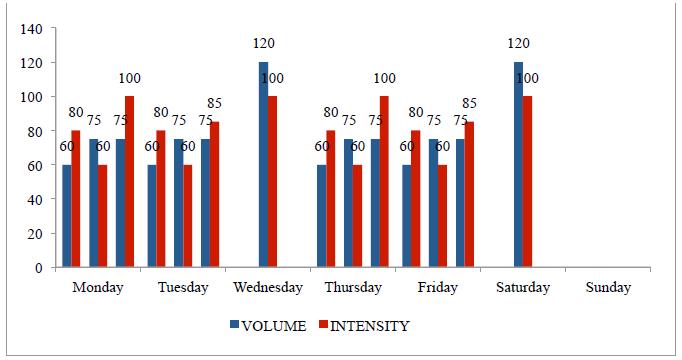
We present below the program of activities for a day with three training sessions, and for a day with
just one training session.
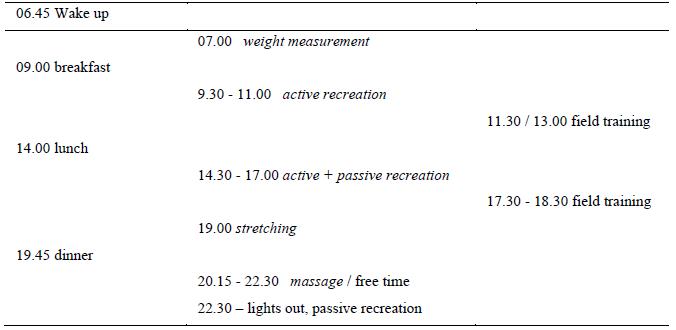
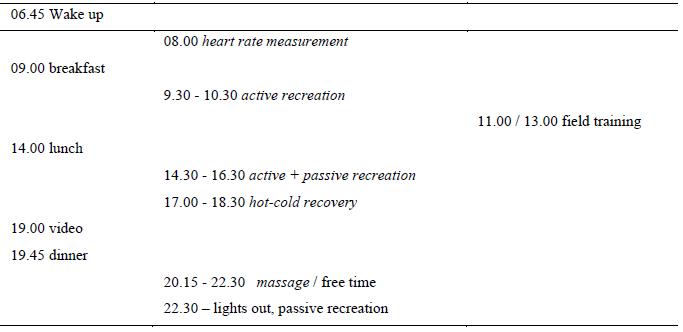
Once described the general picture of specific activities of the centralized training sessions, we can
show the recommendations on guidance recovery schemes that will emphasize means of active
recovery, the very essence of this research.
The recommendations on intra-effort recovery are concerning the content of the breaks between
reps, sets, and training sequences. Thus, most experts support active recovery during these breaks,
representing sub maximal motor structures made in order to maintain the performance level between
training activities (Hausswirth & Mujika, 2013: 29). At the same time, it should be noted that in the
case of maximum efforts lasting less than 6 seconds, passive recovery of a suitable duration is
preferable, as it does not weaken performance (30"-120") (Dupont et al., 2004, quoted by Hausswirth
& Mujika, 2013: 31). In this research, intra-effort correlates with the intensity and volume of the
structures, and we used both passive and active recovery, which consisted in Fartlek, walking,
breathing exercises and muscle relaxation. At the end of the training session, we applied the following
active recovery scheme: 100m running 15%; 150m running 50% for predominantly anaerobic exercise,
and 75% for predominantly aerobic exercise or mixed exercise; 100m running 25%; 150m running
50% for predominantly anaerobic exercise, and 75% for predominantly aerobic exercise or mixed
exercise; 50m walking with muscle relaxation and breathing exercises; muscle stretching exercises,
mild/ moderate intensity, 10" for each large muscle group, one repeat.
Throughout the recovery sequences, hydration was ensured with still mineral water, 500ml, ingested
in small quantities. Also, after the training session and shower, the athletes performed a sequence of
lower-body immersion in cold water with ice (below 5 degrees Celsius), 30"-60", 1-2 repetitions. This
immersion is mainly aimed at reducing muscle and joint inflammatory processes (Hausswirth, 2010:
35).
Daily recovery includes passive and active recreation, according to the abovementioned framework
programs, and the stretching sequence. This sequence was done on the days with three training
sessions, according to the program described above, by progressive passive stretching, according to the
following algorithm: 6 series (5"-10"-15"-20"-25"-30") for each muscle group concerned, alternatively,
6-8 exercises, sub maximal amplitude, with a partner. This type of stretching helps to reduce joint
stiffness, favours muscle elasticity, soothes the psyche of the athlete (Hausswirth, 2010: 3) and
prevents sports accidents. This algorithm resulted from the collaboration with INCS Bucharest, the
director of the institution, Pierre de Hillerin. Daily recovery was complemented with hydration,
nutrition, medication and rehabilitation massage, knowing that “a 5-minute massage can recover as a
20-minute passive break” (Rouges, quoted by Weineck, 1995).
The micro cycle recovery was completed with a hot-cold sequence, according to the framework
program, consisting of: immersion in cold water (8-10 degrees Celsius) with the whole body, for 2-3
minutes, alternating with dry sauna, 10-12 minutes, in 3 series. The purpose of the recovery, due to hot-
cold alternation, is to favour venous circulation with its beneficial effects. Note that the sequence
begins and ends with cold water.
For the biological control of recovery, we measured the body weight and heart rate, according to the
methodology described above. The results obtained are shown below.
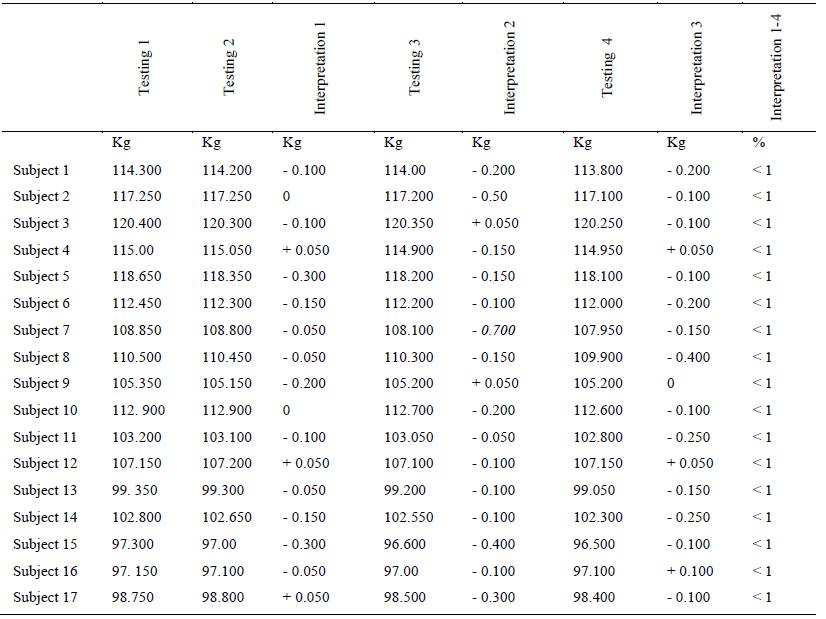
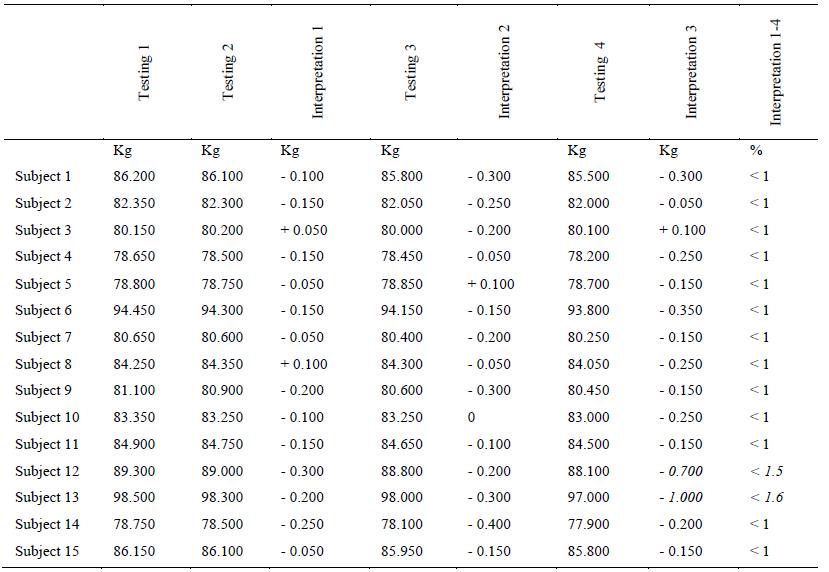
The results obtained in measuring the body weight in the case of the forward compartment show
variations of up to 300g in the micro cycle 1, and up to 500g in the micro cycle 2. In the backs, we can
see variations of up to 300g in the micro cycle 1 and up to 1000g in the micro cycle 2. These variations
are primarily weight loss.
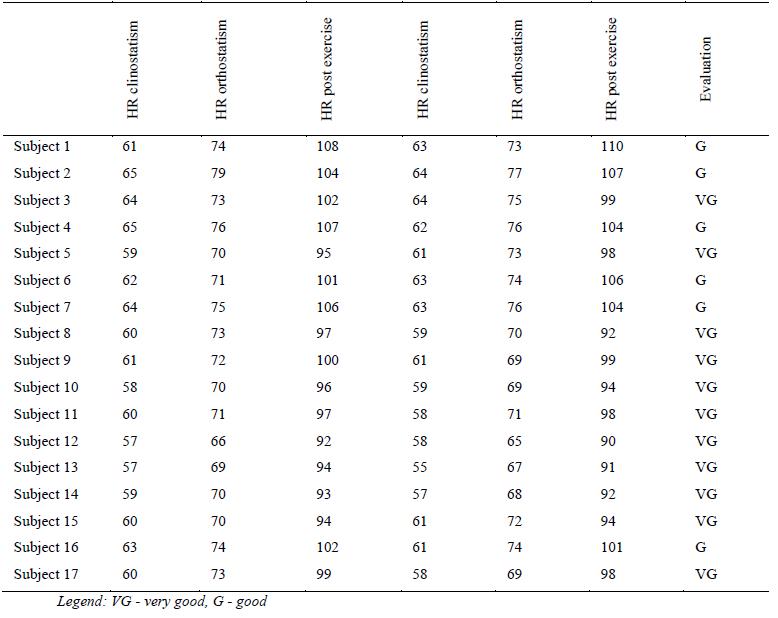
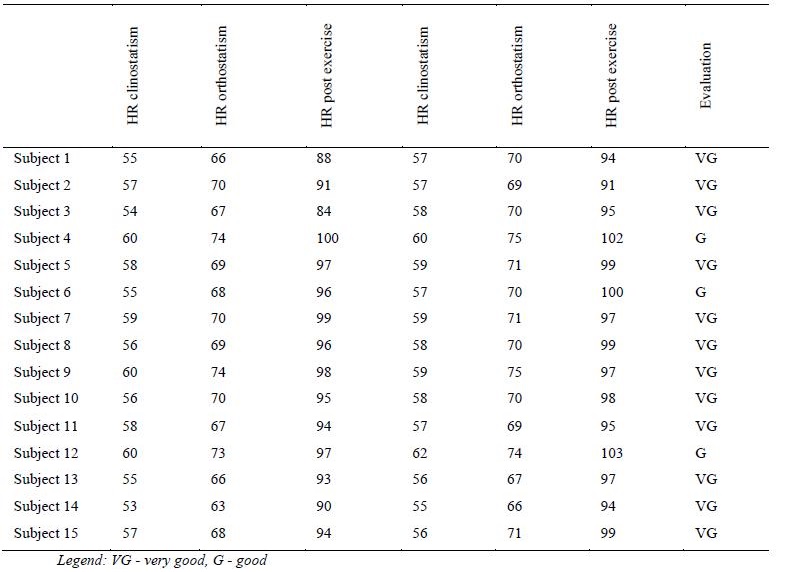
Heart rate results in micro cycles 1 and 2, in the forward compartment, reflect variations of 9 to 14
beats/minute between the clinostatic measurement and the orthostatic measurement, reaching a
difference of 37 beats/minute between the orthostatic measurement and the post effort measurement.
On the backs compartment, we see similar variations between the clinostatic measurement and the
orthostatic measurement, but the difference is smaller, of only 30 beats/minute, between the orthostatic
measurement and the post effort measurement.
Discussions and conclusions
The scientific approach has resulted in proposals concerning the intra- and post effort recovery of
the players.
First, we must emphasize the framework programs used for this research. They ensure a correct
dosage and correct alternation in terms of training sequences and recovery sequences, thus ensuring the
frame of an efficient training.
Most studies on the effects of active or passive recovery reflect the positive influences of active
recovery with respect to passive recovery (Hausswirth & Mujika, 2013: 29). Therefore, the intra-effort
recovery proposed within the research is mainly active, according to the pattern presented in the
research results.
Research on stretching underlines that its use as a singular recovery method is not recommended.
However, the use of muscle strains associated with other methods of recovery has optimal results
(Hausswirth & Mujika, 2013: 67). Consequently, our work shows two alternatives of muscle strains
associated with and adapted to the recovery process and the peculiarities of rugby.
Recovery by immersion in water at different temperatures has many benefits (Hausswirth & Mujika,
2013: 199). Proposals for rehabilitation methods used in the research describe two types of immersion
in cold water, immediately after effort, and associated with sauna, in the hot-cold recovery sequence.
The results obtained after measuring the body weight and the heart rate reveal the following:
• Accepting the opinion of sports doctors, who argue that a variation of less than 3% of the body
weight during various stages of preparation is tolerable, and a variation of +/- 1kg/24 hours is
allowed (Drăgan, 2002), we can say that the recorded values are lower than those mentioned above,
the changes in the body weight of the players are normal, and the level of recovery of the exercise
capacity is adequate;
• The evolution of results following the measuring of the heart rate is evaluated positively, since
variations of the values of the three measurements fall within tolerable limits. We support this
assertion given that players are in the period of preparation, and therefore we can explain the slightly
higher values of heart rate, to which we add the morphofunctional peculiarities of the rugby players
on positions. Consequently, we can state that the recovery was adequate.
References
Badea, D. (2012). Rugby – Stategia formativă a jucătorului (Ediția a II-a). București: Editura Universitară. Creţu, A., & Bratu, M. (2003). Refacere în sport. Bucureşti: Editura Alexandru 27.
Drăgan, I. (2002). Medicina sportivă. Bucureşti: Editura Medicală.
Hausswirth, C. (2010). Fiches pratiques pour la récuperation en sport. Valognes: Le Reverend.
Hausswirth, C., & Mujika, I. (2013). Recovery for Performance in Sport. Champaign, IL: Human Kinetics. Weineck, J. (1995). Biologia sportului (Vol. II). Bucureşti: MTS-CCPS.
Copyright information

This work is licensed under a Creative Commons Attribution-NonCommercial-NoDerivatives 4.0 International License.
About this article
Publication Date
10 June 2016
Article Doi
eBook ISBN
978-1-80296-010-5
Publisher
Future Academy
Volume
11
Print ISBN (optional)
-
Edition Number
1st Edition
Pages
1-509
Subjects
Sports, sport science, physical education
Cite this article as:
Badea, D. (2016). The Recovery of the Effort Capacity during Training Camps. In V. Grigore, M. Stanescu, & M. Paunescu (Eds.), Physical Education, Sport and Kinetotherapy - ICPESK 2015, vol 11. European Proceedings of Social and Behavioural Sciences (pp. 128-135). Future Academy. https://doi.org/10.15405/epsbs.2016.06.18

